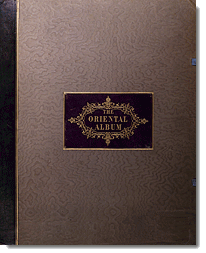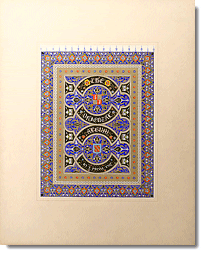 |
|||||
Three years ago, the Research Institute for Languages and Cultures of Asia and Africa named its exhibition as “Splendid Afghanistan 1848: James Rattray's Lithographs of the Costumes and the Scenery.” At that time, we wanted to show how Afghanistan, the country that media was infusing to be under the influence of wars, terrorism, and massacres showing gloomy images, was actually a country with a surprisingly splendid and rich culture. Therefore, we decided to rename the exhibition as “Fertile Nile Valley: Prisse d'Avennes's Lithographs of the Characters, the Costumes and the Modes of Life,” depicting the popular image of Egypt being a fertile agricultural country since ancient times and acting as a granary for the Eastern Mediterranean region. “Fertile” seems a natural adjective that comes to mind when seeing the cultural variety of the peoples residing in the Nile valley, as depicted in the lithographs of the exhibition. The characters “埃及” in the Japanese title mean “Egypt,” and are the characters currently used in Chinese.
After pursuing a diploma in architecture from the French Royal School of Arts and Crafts, Prisse d'Avennes traveled to Egypt in 1827 and worked as a technician under Muḥammad ʻAlī's government, which was zealously promoting modernization with economic, military and industrial development policies. Then, he resigned in 1836, took up Egyptology, and became involved in researching and excavating historic ruins. Prisse d'Avennes dedicated this publication to George Lloyd, a Welsh who had worked as his assistant in excavation work for two years since 1841, and had died in an accident in 1843 at the young age of 28. Lloyd was the one who encouraged Prisse d'Avennes to draw the very sketches that later became the Oriental Album, and a portrait of him in Egyptian attire holding a shīsha (water pipe) that is featured in the opening pages of Oriental Album. A combination of Egyptologist Prisse d'Avennes's strong interest in the peoples of his time, his accurate drawing skills as a trained architect, and the encouragement by a young friend that gave birth to this extremely valuable archives of images that show us the manners and customs of the Nile valley.
An accurate eye Prisse d'Avennes's Oriental Album depicts the lives of peoples from various classes residing in the Nile valley with bright colors providing minute details. European travelers tended to focus on depicting the ancient colossal structures and seldom paid much attention to the peoples living there. In contrast, Prisse d'Avennes sketched not only peoples' clothes, ornaments, furniture, accessories, and living necessities but also the weapons used by soldiers, warriors, guards, and nomads, equipment for camels, and women's tattoos, with particular determination and application. Let us attempt to find the women's veils, a much discussed topic today, in Prisse d'Avennes's sketches. We are inclined to believe that Muslim women hide their faces with veils when leaving their homes; however, even on excluding the dancers (lithograph 2) and young girls (lithographs 7 and 9), the female Egyptian peasants in lithographs 14 to 17 are not seen hiding their faces. Although lithographs 4 and 10 showed that Cairene women probably hid their faces with veils, the only peasant woman wearing a burquʻ is seen in lithograph 13. At that time, burquʻs were considered for the women of higher classes as clothes to be worn on streets, and not for lower class women such as peasants. Prisse d'Avennes's lithographs show us accurately these facts.
|
|
|
 The artwork of Émille Prisse d'Avennes, displayed in this exhibition, was published in London in 1848 as Oriental Album: Characters, Costumes, and Modes of Life, in the Valley of the Nile.
The artwork of Émille Prisse d'Avennes, displayed in this exhibition, was published in London in 1848 as Oriental Album: Characters, Costumes, and Modes of Life, in the Valley of the Nile. An Account of the Manners and Customs of the Modern Egyptians (1836-37) by Edward William Lane, British Arabist, is considered as a monumental work among the Europeans ethnographic studies on Egypt. Lane lived in Cairo from 1826 for two and a half years, and again from 1833 to 1835. Originally intending to obtain reference for translating Arabian Nights, he collected information on various aspects of Egyptian society into two volumes, together with his original illustrations. His depictions stand out as being decisively accurate, detailed, and systematic; however, the illustrations were unfortunately not in color. On the other hand, Prisse d'Avennes lived in Egypt for 17 years from 1827 to 1844 and again from 1858 to 1860, dressed as the locals, named himself Idrīs Efendī, and completely immersed himself in the local society. His years spent in Egypt were four times that spent by Lane, and if he himself had added detailed commentaries to his own artwork, the value of the publication as ethnographic material would have been exceedingly elevated.
An Account of the Manners and Customs of the Modern Egyptians (1836-37) by Edward William Lane, British Arabist, is considered as a monumental work among the Europeans ethnographic studies on Egypt. Lane lived in Cairo from 1826 for two and a half years, and again from 1833 to 1835. Originally intending to obtain reference for translating Arabian Nights, he collected information on various aspects of Egyptian society into two volumes, together with his original illustrations. His depictions stand out as being decisively accurate, detailed, and systematic; however, the illustrations were unfortunately not in color. On the other hand, Prisse d'Avennes lived in Egypt for 17 years from 1827 to 1844 and again from 1858 to 1860, dressed as the locals, named himself Idrīs Efendī, and completely immersed himself in the local society. His years spent in Egypt were four times that spent by Lane, and if he himself had added detailed commentaries to his own artwork, the value of the publication as ethnographic material would have been exceedingly elevated.


